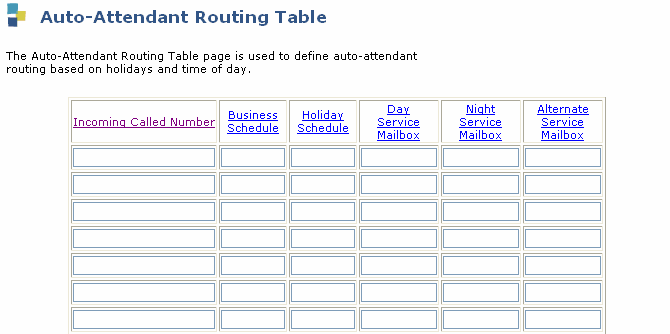| Incoming Called Number
|
From 1 to 8 alphanumeric characters
|
The numbers to be redirected. These can be any incoming numbers
reported to the messaging software by the switch, for example, perhaps
an incoming trunk number or an extension number that the caller dialed.
If a number appears twice in this column, the first instance prevails.
For example, 802 appears before the range 802806, and is treated
separately per its first appearance. However, 805 appears after the
range of numbers, so it is treated as set out on the line associated
with the range, and ignored.
|
| Business Schedule
|
From 1 to 8
alphanumeric characters
From 1 to 4
|
The name or number of the business schedule that determines how
the incoming number is treated. The name loginis reserved to indicate
that a direct, external call to the associated incoming number is
allowed to log in; that is, if you call in over this trunk, the messaging
software asks you to log in.
|
| Holiday Schedule
|
1- to 8-
alphanumeric characters
1-4
|
The name or number of the holiday schedule (if any) that determines
how the incoming number is treated on holidays.
|
| Day Service Mailbox
|
An existing mailbox extension
|
All automated attendant mailbox extensions must be defined before
they can be entered in these columns.
Type the extension number of the automated attendant mailbox to
be accessed during the business hours given in the business schedule.
This field must be filled in if the associated business schedule specifies
day service hours.
|
| Night Service Mailbox
|
An existing mailbox extension
|
Type the extension number of the automated attendant mailbox to
be accessed during the period not otherwise specified in the business
schedule.
|
| Alternate Service Mailbox
|
An existing mailbox extension
|
The extension number of the automated attendant mailbox to be accessed
during the alternate-service period given in the business schedule.
This field must be filled in if the associated business schedule specifies
alternate service hours.
|

